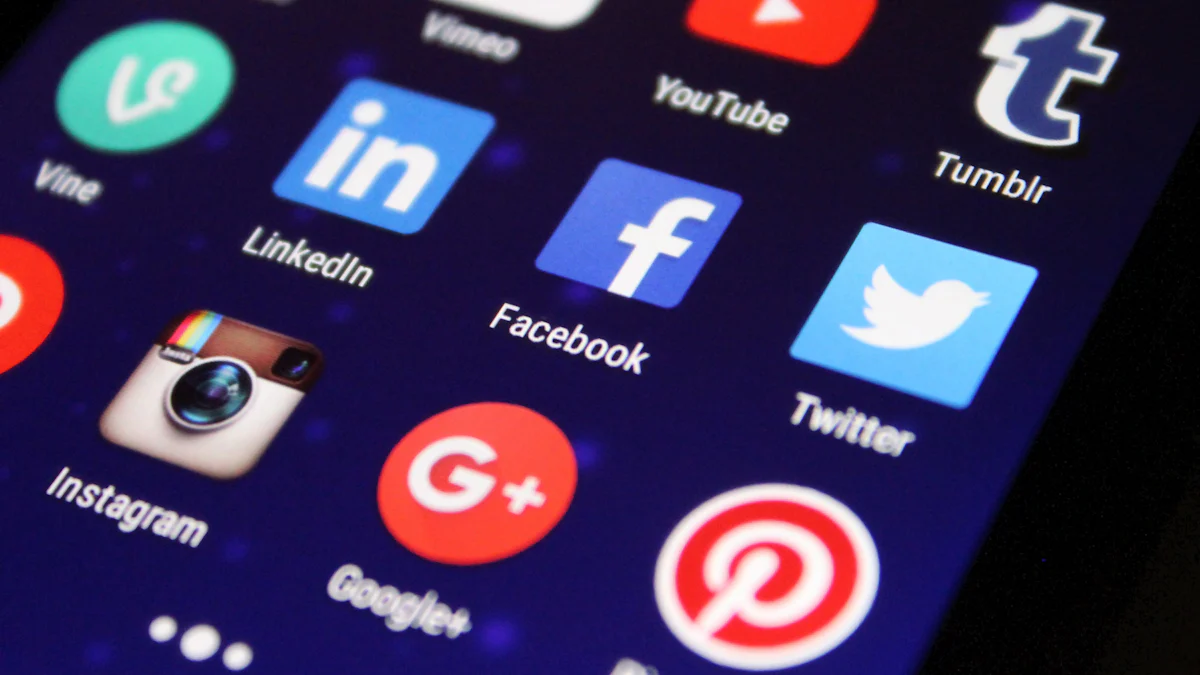What to Expect from Influencer Marketing in 2025

The world of influencer marketing is evolving faster than ever. By 2025, the market is expected to surpass $22 billion, a significant leap from $9.7 billion in 2020. This growth reflects how brands are adapting to emerging trends and leveraging cutting-edge technologies like AI. Tools powered by AI now help brands discover influencers, manage campaigns, and predict outcomes with precision. Meanwhile, creators are finding fresh ways to connect with audiences, from immersive metaverse experiences to hyper-personalized content. Whether you're a marketer or an influencer marketing agentur, staying ahead of these shifts is key to thriving in this dynamic space.
AI Transforming Influencer Marketing

AI-Powered Influencer Discovery
Finding the right influencer for your brand can feel like searching for a needle in a haystack. By 2025, AI will make this process smarter and faster. Instead of relying on broad demographics, AI tools will analyze follower behaviors and engagement patterns to match influencers with your brand’s goals.
AI will go beyond broad demographic categories. It will help identify influencers whose followers exhibit behaviors and engagement patterns that align with brand goals.
This shift is already happening. Over 55% of marketers plan to use AI tools for influencer identification, and 63% of brands aim to integrate AI into their influencer marketing campaigns by 2024. These tools will save you time and ensure your campaigns connect with the right audience.
Predictive Analytics for Campaign Success
Imagine knowing how successful your campaign will be before it even starts. Predictive analytics makes this possible. By analyzing past data, AI helps you choose influencers whose content style and audience align with your goals.
| Benefit | Description |
|---|---|
| Enhanced Decision-Making | Brands use past data to select influencers based on content style, audience, and past results, leading to better alignment with goals. |
| Improved Campaign Performance | Predictive analytics forecasts campaign success, helping brands set realistic goals and budgets. |
| Risk Reduction | It identifies potential issues early, such as fake followers or misaligned values, preventing costly partnerships. |
With these insights, you can set realistic budgets, avoid risks, and create campaigns that deliver results.
AI-Generated Content and Virtual Influencers
AI isn’t just helping you find influencers—it’s creating them. Virtual influencers like Lil Miquela and Magalu are already making waves. Lil Miquela, for example, transitioned from a digital experiment to a mainstream influencer, even partnering with brands like Calvin Klein to boost engagement by 60%.
Brands are also using AI to generate creative content. Burger King’s Million Dollar Whopper campaign used AI to design a burger creator website, while Heinz employed AI image generators to inspire user-generated content. These campaigns show how AI can help you stand out in a crowded market.
By 2025, expect more brands to embrace virtual influencers and AI-generated content as part of their strategy. These tools will allow you to create unique, engaging campaigns that resonate with your audience.
Authenticity as a Cornerstone of Influencer Marketing
Why Authenticity Matters in 2025
Authenticity is no longer optional in influencer marketing—it’s essential. By 2025, audiences will demand genuine connections with influencers. People are tired of overly polished posts that feel more like ads than real-life moments. They want influencers who stay true to their values and share relatable content.
Why does this matter? Authentic influencers build trust. Their followers see them as credible and are more likely to engage with their content. This trust leads to higher engagement rates and fosters long-term relationships. When influencers are authentic, they create a sense of community, which strengthens loyalty and boosts your brand’s reputation.
Here’s a stat to consider: 85% of influencers and 67% of marketers agree that trust and authenticity are the most important aspects of influencer marketing. If you want to stay ahead of influencer marketing trends, putting an emphasis on authenticity is key.
Strategies for Building Authentic Campaigns
Creating authentic campaigns starts with finding the right influencers. Look for creators who align with your brand’s values and have a genuine connection with their audience. Avoid influencers who promote too many brands—it can dilute their credibility.
Once you’ve found the right fit, focus on collaboration. Let influencers share your message in their own voice. This approach feels more natural and resonates better with their followers. Encourage them to share behind-the-scenes moments or personal stories that tie into your brand.
Transparency is another critical piece of your strategy. Make sure influencers disclose partnerships clearly. Audiences appreciate honesty, and it builds trust in both the influencer and your brand.
Measuring Authenticity in Influencer Marketing
Measuring authenticity might seem tricky, but it’s doable with the right metrics. Start by analyzing the quality of interactions between the influencer and their followers. Look at engagement metrics like likes, comments, and shares. High-quality comments—those that show genuine interest—are a strong indicator of authentic engagement.
You should also review the influencer’s past partnerships. Have they worked with brands that align with your values? If they’ve collaborated with too many brands, it might signal a lack of authenticity.
Finally, consider the demographics of their audience. Are they reaching the people you want to target? Authenticity isn’t just about the influencer—it’s about how well they connect with the right audience.
By focusing on these strategies and metrics, you can ensure your campaigns deliver authentic engagement and meaningful results.
The Rise of Micro-Influencers and Hyper-Niche Influencers

Why Micro-Influencers Dominate Influencer Marketing Trends
Micro-influencers are taking the spotlight in influencer marketing. These creators might have smaller followings, but their impact is anything but small. Why? Their audiences trust them more. They feel relatable, like a friend sharing honest recommendations. This connection leads to higher engagement rates—up to 60% more than larger influencers.
Marketers are catching on. Nearly 44% of brands now prefer micro-influencers because they’re cost-effective and deliver better results. You can stretch your budget further while still reaching a highly engaged audience. It’s a win-win for both brands and influencers.
| Statistic | Value |
|---|---|
| Engagement Rate | Up to 60% more than other influencers |
| Preference by Marketers | 44% prefer micro-influencers due to lower costs |
Building Long-Term Partnerships with Micro-Influencers
If you want consistent results, think long-term. Building lasting relationships with micro-influencers can transform your strategy. These influencers are more likely to collaborate on interviews, commission-based sales, or even become brand ambassadors.
Having long-term relationships with influencers is the key to consistent and impactful marketing efforts since an audience is more likely to engage with a brand that they have seen over a series of engagements.
When you work with the same influencers over time, their audience starts associating your brand with trust and authenticity. This approach also gives you access to niche demographics that are hard to reach through traditional methods.
These partnerships provide the perfect opportunity to gain immediate trust and access to demographics that are extremely difficult to reach through traditional methods.
Scaling Campaigns with Micro and Hyper-Niche Influencers
Scaling your campaigns doesn’t mean going big—it means going smart. Hyper-niche influencers can help you deliver tailored messages to specific communities. Their deep connection with their audience ensures your message resonates.
To scale effectively:
- Focus on quality over quantity when choosing influencers.
- Check engagement rates to ensure they connect with their followers.
- Align their values with your brand to maintain credibility.
Hyper-local influencers are also a game-changer. They can target specific regions or communities, making your campaigns feel personal. Plus, micro-influencers’ cost efficiency allows you to partner with multiple creators, maximizing your budget and content variety.
By leveraging these strategies, you can scale your campaigns while keeping them authentic and impactful.
Inclusivity and Sustainability in Influencer Marketing
The Role of Inclusivity in Influencer Marketing Trends
Inclusivity is no longer just a buzzword—it’s a necessity. Today’s socially conscious consumers expect brands to reflect their values. Inclusive representation in influencer marketing helps you connect with diverse audiences and build trust. When you partner with influencers who represent varied experiences, you show your audience that you value diversity.
Why does this matter? Inclusive marketing drives higher engagement and fosters lasting relationships. People want to see themselves represented in the content they consume. By embracing diversity, you enhance your brand’s authenticity and expand your reach. It’s not just a trend; it’s a strategic move that aligns your business with a socially aware audience.
Here’s how brands are leading the way:
- They’re prioritizing partnerships with diverse creators.
- They’re emphasizing representation in campaigns.
- They’re building stronger connections by reflecting their audience’s experiences.
If you want to stay ahead of influencer marketing trends, inclusivity should be at the core of your strategy.
Sustainability as a Key Message in 2025
Sustainability is shaping the future of influencer marketing. Consumers are more eco-conscious than ever, and they expect brands to follow suit. By 2025, sustainability will be a key message in campaigns. Influencers are already leading the charge, promoting sustainable living and eco-friendly products.
Take a look at these examples:
| Influencer | Campaign Description | Brand |
|---|---|---|
| Jessica Clifton | Provides tips on sustainable living and partners with eco-friendly brands. | Grove Collaborative |
| Andrew Burgess | Created upcycled sneakers for Puma's sustainable fashion campaign. | Puma |
| Rob Greenfield | Collaborated with VIVOBAREFOOT to promote shoe recycling and environmental activism. | VIVOBAREFOOT |
These campaigns highlight how influencers can amplify your sustainability message. Whether it’s promoting sustainable packaging or encouraging recycling, their content resonates with eco-conscious audiences.
To make an impact, focus on authenticity. Partner with influencers who genuinely care about sustainability. Their passion will shine through, making your campaigns more relatable and effective.
Measuring the Impact of Inclusive and Sustainable Campaigns
How do you know if your campaigns are working? Measuring the impact of inclusivity and sustainability requires the right metrics. Start by tracking engagement rates. Are people liking, commenting, and sharing your content? High-quality interactions indicate success.
You should also analyze reach and impressions. How many unique users are seeing your content? Are you reaching the right audience? Dive into audience demographics to ensure your message resonates with your target group.
Other key metrics include:
- Click-through rate (CTR): How many users click on your links?
- Conversion rate: Are people taking action after seeing your campaign?
- Sentiment analysis: What emotions does your content evoke?
Finally, calculate your return on investment (ROI). Compare the revenue generated to your campaign costs. A strong ROI shows that your inclusive and sustainable efforts are paying off.
By focusing on these metrics, you can refine your strategy and create campaigns that truly make a difference.
Social Commerce and Influencer Marketing Integration
Influencers Driving Social Commerce
Social commerce is booming, and influencers are at the heart of this trend. Their ability to connect with followers on a personal level makes their recommendations feel like advice from a trusted friend. This connection drives purchases like never before. Did you know that 49.5% of US social shoppers have bought something because of influencer content? For Gen Z, that number jumps to an impressive 82%. Even Gen X shoppers, at 40.8%, are swayed by creators’ endorsements.
Social media platforms also play a role. Algorithms personalize product recommendations based on user behavior. This ensures that the right products appear in front of the right people. It’s like having a personal shopper who knows exactly what you want. When influencers showcase these products, it enhances the shopping experience and boosts sales.
Influencers don’t just promote products—they build trust. Their endorsements can help your brand break into new markets and establish credibility.
Leveraging Social Commerce Platforms
To succeed in social commerce, you need the right strategy. Start by choosing influencers who align with your brand values. Their followers are more likely to trust their recommendations if they feel authentic. Transparency in paid partnerships is also crucial. Make sure influencers disclose their collaborations clearly.
Authentic content is another must. Showcase your products naturally, like they’re part of everyday life. Exclusive deals can also work wonders. Limited-time offers create urgency and encourage immediate purchases. Don’t forget to engage with followers. Respond to comments and foster a sense of community. This interaction builds loyalty and keeps your audience coming back.
Finally, track your performance. Monitor metrics like engagement rates and conversions to refine your approach. A data-driven strategy ensures your campaigns stay effective and impactful.
Data-Driven Social Commerce Strategies
Data is your best friend when it comes to social commerce. Start by focusing on transparency. Authentic content builds trust and relatability, which are key to driving sales. Offering exclusive deals can also boost conversions. Promotions create urgency and encourage followers to act quickly.
Engagement is another critical factor. Encourage influencers to interact with their audience during live sessions. This real-time connection fosters community and drives sales. Emerging technologies like AR and VR can also elevate your campaigns. Imagine letting followers try on products virtually before buying them. AI-powered recommendations can further personalize the shopping experience, making it seamless and enjoyable.
To measure success, track key metrics. Look at sales and conversion rates to see how your campaigns impact revenue. Engagement metrics like likes and comments show how well your content resonates. Click-through rates reveal interest in your products, while ROI helps you evaluate profitability. Don’t forget to gather customer feedback. It provides valuable insights to improve your offerings and campaigns.
By combining transparency in paid partnerships with data-driven strategies, you can create impactful social commerce campaigns that resonate with your audience.
Emerging Formats and Platforms in 2025
The Power of Short-Form Video and Live Streaming
Short-form videos and live streaming are reshaping how influencers connect with audiences. Platforms like TikTok and Instagram Reels have made short videos a favorite among social media algorithms, giving them greater reach. These bite-sized clips grab attention quickly and deliver high ROI for campaigns. To make the most of this trend, you should focus on creating mobile-friendly content with attention-grabbing hooks.
Live streaming is another game-changer. It allows influencers to engage with their followers in real time, creating a sense of immediacy and trust. For example, Dr. Elena Jones hosted a live session offering beauty tips while linking to products. This approach kept her audience engaged even after the event ended. Live shopping also works wonders. About 35% of consumers say exclusive discounts during live streams motivate them to make purchases. Tracking live stream performance helps brands identify best-selling products and measure conversion rates.
The Role of the Metaverse in Influencer Marketing
The metaverse is opening up exciting possibilities for influencer marketing. Imagine hosting a virtual product launch where attendees can interact with your brand in an immersive environment. This level of engagement goes beyond traditional social media. Virtual influencers are also making waves. They allow you to maintain creative control while delivering consistent messaging, especially to younger audiences.
The metaverse’s global reach is another advantage. It lets you connect with audiences without physical limitations, boosting brand awareness and community engagement. By 2025, expect more brands to explore this space to create memorable experiences that resonate with tech-savvy consumers.
Influencers Shaping Brand Strategies Beyond Content Creation
Influencers are no longer just content creators—they’re strategic partners. Take GoPro, for instance. They collaborate with extreme sports influencers who use their cameras in real-world scenarios. The user-generated content is then shared on GoPro’s channels, showcasing the product’s capabilities authentically.
Nike’s partnership with fitness influencer Chloe Ting is another great example. Chloe incorporated Nike products into her workout routines, highlighting their performance and comfort. Her genuine connection with her audience made the campaign highly effective.
Influencer-generated content also serves as valuable creative assets. It often outperforms traditional brand-created content in terms of engagement and conversions. Brands can repurpose this content across channels like paid social advertising, email marketing, and retargeting campaigns. Long-term partnerships with influencers can boost brand awareness, improve search engine rankings, and foster customer loyalty.
| Aspect | Description |
|---|---|
| Creative Assets | Influencer-generated content can be repurposed across multiple channels. |
| Engagement | This content often drives higher engagement than traditional brand-created assets. |
| Marketing Strategy Insights | Insights from influencer campaigns help optimize overall marketing strategies. |
By collaborating with influencers strategically, you can unlock new opportunities to grow your brand.
Influencer marketing in 2025 is set to redefine how brands connect with their audiences. To stay competitive, you’ll need to embrace trends like AI, authenticity, inclusivity, and sustainability. These elements aren’t just buzzwords—they’re the foundation of successful campaigns.
Here’s what you can do to adapt:
- Focus on long-lasting campaigns that can be repurposed across platforms.
- Incorporate influencers into multichannel strategies for cohesive messaging.
- Use AI tools to identify influencers who align with your values and goals.
- Prioritize authenticity and transparency to build trust with your audience.
Authenticity is key. Audiences demand genuine connections, and brands that deliver will thrive in 2025.
By leveraging these insights, you can create campaigns that resonate deeply with your audience. This approach not only strengthens your brand’s reputation but also drives long-term growth. The future of influencer marketing is bright—are you ready to embrace it?
FAQ
What is the biggest trend in influencer marketing for 2025?
AI is leading the charge! From finding the perfect influencer to predicting campaign success, AI tools are transforming how you plan and execute strategies. Virtual influencers and AI-generated content are also gaining traction, offering creative ways to engage audiences. 🚀
How do I choose the right influencer for my brand?
Focus on alignment. Look for influencers whose values and audience match your brand. Use AI tools to analyze engagement rates and audience demographics. Authenticity matters—pick someone who genuinely connects with their followers.
Are micro-influencers better than big-name influencers?
Yes, in many cases! Micro-influencers have smaller but highly engaged audiences. Their followers trust them more, which leads to better results. Plus, they’re cost-effective, making them a smart choice for brands with tight budgets.
How can I measure the success of an influencer campaign?
Track key metrics like engagement rates, click-through rates, and conversions. Use sentiment analysis to gauge audience reactions. Don’t forget ROI—it shows how much revenue your campaign generates compared to its cost.
Is the metaverse really important for influencer marketing?
Absolutely! The metaverse offers immersive experiences that go beyond traditional platforms. Virtual product launches and interactive events can help you connect with tech-savvy audiences. It’s a game-changer for brands looking to innovate.
Tip: Start exploring metaverse opportunities now to stay ahead of the curve!
See Also
Key Influencer Marketing Trends You Should Follow in 2024
15 Essential Influencer Marketing Platforms for Your 2024 Strategy
Effective TikTok Influencer Marketing Techniques for 2024
Grasping the Basics of Influencer Marketing Return on Investment
Practical Influencer Marketing Statistics for Better Strategy Development
